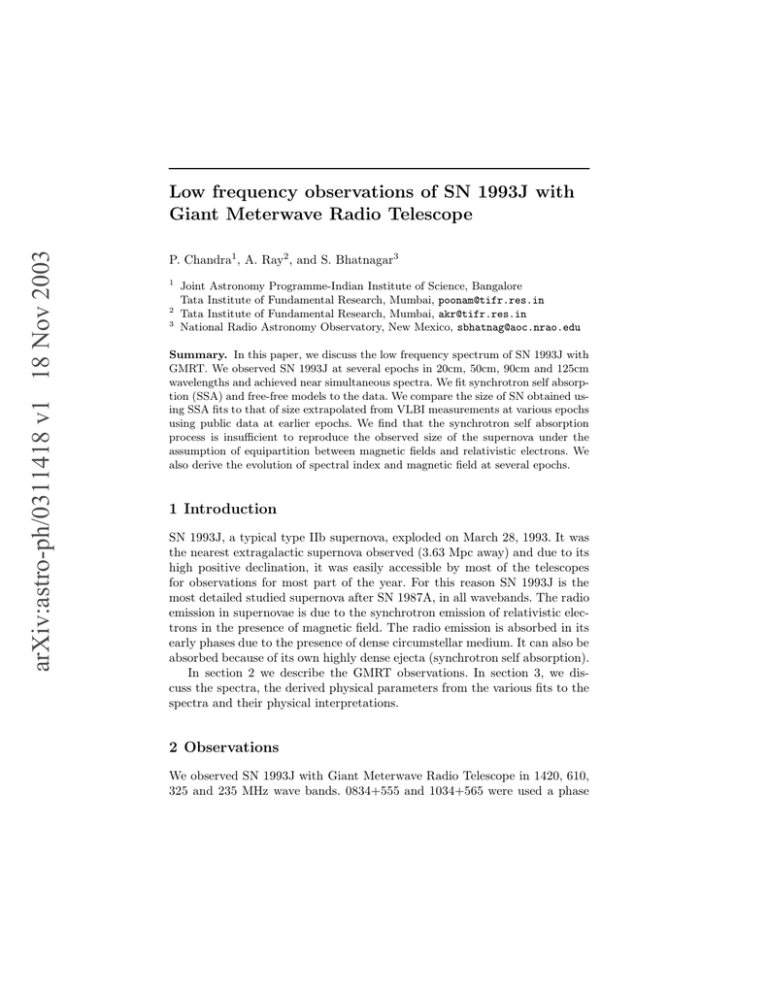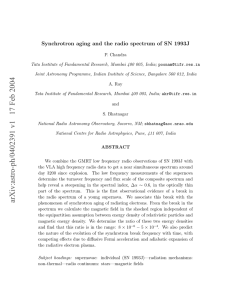Low frequency observations of SN 1993J with Giant Meterwave Radio Telescope
advertisement

arXiv:astro-ph/0311418 v1 18 Nov 2003 Low frequency observations of SN 1993J with Giant Meterwave Radio Telescope P. Chandra1 , A. Ray2 , and S. Bhatnagar3 1 2 3 Joint Astronomy Programme-Indian Institute of Science, Bangalore Tata Institute of Fundamental Research, Mumbai, poonam@tifr.res.in Tata Institute of Fundamental Research, Mumbai, akr@tifr.res.in National Radio Astronomy Observatory, New Mexico, sbhatnag@aoc.nrao.edu Summary. In this paper, we discuss the low frequency spectrum of SN 1993J with GMRT. We observed SN 1993J at several epochs in 20cm, 50cm, 90cm and 125cm wavelengths and achieved near simultaneous spectra. We fit synchrotron self absorption (SSA) and free-free models to the data. We compare the size of SN obtained using SSA fits to that of size extrapolated from VLBI measurements at various epochs using public data at earlier epochs. We find that the synchrotron self absorption process is insufficient to reproduce the observed size of the supernova under the assumption of equipartition between magnetic fields and relativistic electrons. We also derive the evolution of spectral index and magnetic field at several epochs. 1 Introduction SN 1993J, a typical type IIb supernova, exploded on March 28, 1993. It was the nearest extragalactic supernova observed (3.63 Mpc away) and due to its high positive declination, it was easily accessible by most of the telescopes for observations for most part of the year. For this reason SN 1993J is the most detailed studied supernova after SN 1987A, in all wavebands. The radio emission in supernovae is due to the synchrotron emission of relativistic electrons in the presence of magnetic field. The radio emission is absorbed in its early phases due to the presence of dense circumstellar medium. It can also be absorbed because of its own highly dense ejecta (synchrotron self absorption). In section 2 we describe the GMRT observations. In section 3, we discuss the spectra, the derived physical parameters from the various fits to the spectra and their physical interpretations. 2 Observations We observed SN 1993J with Giant Meterwave Radio Telescope in 1420, 610, 325 and 235 MHz wave bands. 0834+555 and 1034+565 were used a phase 2 P. Chandra, A. Ray, and S. Bhatnagar calibrators. 3C48 and 3C147 were used as flux and bandpass calibrators. The data was analyzed using the Astronomy Image Processing Software (AIPS). Figure 1 shows the FOV of SN 1993J at 243 MHz. Right hand upper panel is the zoomed in plot of M82 (neighbouring galaxy in FOV) and lower panel is SN (bottom right) and its parent galaxy M81 (top left). PLot file version 13 created 14-APR-2003 12:07:14 BOTH: SN1993J IPOL 232.625 MHZ 1993J 25.REGRD.1 0.0 0.5 1.0 1.5 69 43 30 00 42 30 DECLINATION (J2000) 00 41 30 00 40 30 00 39 30 00 38 30 09 56 15 00 55 45 RIGHT ASCENSION (J2000) Grey scale flux range= 0.000 1.500 JY/BEAM Cont peak flux = 2.1105E+00 JY/BEAM Levs = 2.000E-02 * (-2, -1, 1, 2, 4, 8, 16, 32, 64, 80, 100, 110, 128, 256, 512, 1024, 2048, 4096) PLot file version 4 created 14-APR-2003 11:29:00 BOTH: SN1993J IPOL 232.625 MHZ 1993J 25.REGRD.1 0 50 100 150 30 200 69 05 00 04 30 DECLINATION (J2000) 00 03 30 00 02 30 00 01 30 00 00 30 00 09 55 45 30 15 RIGHT ASCENSION (J2000) Grey scale flux range= 0.0 200.0 MilliJY/BEAM Cont peak flux = 2.1105E+00 JY/BEAM Levs = 1.300E-02 * (-10, -9, -8, -7, -6, -5, -4, -3, -2, -1, 1, 2, 3, 4, 5, 6, 7, 8, 9, 10) 00 Fig. 1. GMRT contour map of FOV of SN 1993J in 243 MHz band (Observed on Mar8,02). Upper panel is M82 and lower panel is M81 (Top left) and SN 1993J (Bottom right). The table 1 below gives the details of the observations used in this paper. We plot near simultaneous spectra at 4 epochs (See Figure 2). Since the supernova is 10 years old, we do not expect its flux to change by any significant amount in few days. The flux errors quoted in the table 1 are p ((map rms)2 + (10% of the peak f lux of SN )2 ) This 10% of the peak flux error takes into account any possible systematic errors in GMRT as well as any little variation in flux in the short time difference due to near simultaneous spectra. 3 Results and Interpretation We have fit the synchrotron self absorption models to the GMRT data and got the best fit radius, magnetic field and spectral index. We fitted the parameters under the assumption of equipartition which seems to be a reasonable SN 1993J low frequency spectrum with GMRT 3 Table 1. Details of observations of near simultaneous spectra of SN 1993J Jul 5,01 Aug 24,01 Jun 2,01 3022 3072 2988 0.327 0.616 1.393 2.5 2 3 18 24 28 69.2±15.8 55.8±5.7 32.67±3.3 2.5 0.36 0.19 Dec 31,01 Dec 30,01 Oct 15,01 3199 3198 3123 0.239 0.619 1.396 3 1.7 2 20 20 24 57.8±7.6 47.8±5.5 33.9±3.5 2.5 1.9 0.3 Mar 08,02 Mar 07,02 Mar 08,02 Apr 07,02 3266 3265 3266 3296 0.232 0.325 0.617 1.396 3.3 4.1 3 2.3 17 24 25 25 60.9±10.8 56.2±7.4 44.4±4.5 24.6±3.7 4.1 1.9 0.32 1.0 Sep 16,02 Aug 16,02 Sep 16,02 Sep 21,02 3458 3427 3458 3463 0.240 0.331 0.617 1.397 3.4 2 2.7 2 17 16 15 25 56.7±8.7 62.4±8.8 37.5±3.8 24.3±2.4 4.0 2.7 0.4 0.2 100 100 80 80 60 60 Flux in mJy Flux in mJy Date of Days since Frequency Time on No. of Flux density rms Observation explosion in GHz Source (Hrs) Antennae mJy mJy 40 20 40 20 0.2 0.4 0.6 0.8 1 1.4 0.2 0.4 0.6 0.8 1 1.4 1 1.4 Frequency in GHz 100 100 80 80 60 60 Flux in mJy Flux in mJy Frequency in GHz 40 20 40 20 0.2 0.4 0.6 0.8 Frequency in GHz 1 1.4 0.2 0.4 0.6 0.8 Frequency in GHz Fig. 2. Spectrum at four epochs (Clockwise ∼ 8.2, ∼ 8.7, ∼ 9, and ∼ 9.5 years since explosion). Red (solid) line shows the SSA fit and green (dashed) shows the free-free fit. P. Chandra, A. Ray, and S. Bhatnagar SSA Radius in µas 4 1000 1000 VLBI Radius in µas Fig. 3. The fig shows comparison between the VLBI radii of SNe ([1]) and the best fit synchrotron self absorption radius. The straight line is the line where both the radii will be same. Note that best fit SSA radius is much lower than VLBI radii. approximation [5]. Since in the two cases , we have only 3 datasets for the spectrum, we tried different values of spectral index and get the best χ2 fit. We derived the size of the VLBI supernova from [1] and added 5% errorbars to account for any possible error in measurement. Figure 3 shows the plot of best fit synchrotron self absorption radius against VLBI radius at various epochs. For early epochs, we have used VLA public data and data from [4]. The green line is where both the radii are same. It is noteworthy that the synchrotron self absorption radius is significantly smaller than the VLBI radius at all epochs, contrary to findings of [6]. A combined SSA plus free-free fit also did not improve the results. Figure 4 shows the evolution of spectral index and magnetic field with time. We find that the spectrum of SN becomes flatter with time The magnetic field is also decreasing with time, a reason for decreasing radio flux, because synchrotron emission mechanism becomes less efficient as magnetic field decreases. We also calculate the mass loss rate for Te =7×104 K (assuming a constant temperature at these late epochs [3]). Figure 5 shows the radio mass loss rate curve (green,[7]) overlaid on that of X-ray [2] and red points are mass loss rates obtained from GMRT data. Within error bars they seem to fit well with both radio and X-ray curves. Our derived magnetic field given on the right panel of fig. 5 is marginally consistent with that of Bartel [1] under the assumpiton of equipartition between magnetic field and relativistic particles. SN 1993J low frequency spectrum with GMRT 5 1.3 0.7 1.2 0.6 Magnetic Field (Gauss) Spectral Index α 1.1 1 0.9 0.8 0.5 0.4 0.3 0.2 0.7 0.1 0.6 0 0.5 500 1000 1500 2000 2500 Time since explosion (days) 3000 3500 4000 0 500 1000 1500 2000 2500 Time since explosion (days) 3000 3500 4000 Fig. 4. The left panel shows the evolution of spectral index α with time. The right panel shows the evolution of the magnetic field. Fig. 5. Left panel is X-ray mass loss rates (black,[2]) and radio mass loss rate (green,[7]). Red pts. are mass loss rates obtained from GMRT. Right panel shows the mag. field derived from GMRT data (square) superimposed on top of Fig. 13 of [1]. We thank the staff of GMRT (NCRA-TIFR) that made these observations possible. References 1. 2. 3. 4. 5. 6. 7. Bartel, N., Bietenholz,M.F., Rupen, M.P., et al 2002 ApJ, 581, 404 Immler, S., Aschenbach, B., Wang, D., 2001 ApJ, 561, L107 Fransson, C., Bjornsson, C. 1998 ApJ, 509, 861 Perez-Torres, M.A., Alberdi, A., Marcaide, J.M. 2002 A&A, 394, 71 Scott, M.A., Readhead, A.C.S., 1977 MNRAS, 180, 539 Slysh, V.I. 1990, Sov. Astron. Lett., 16(5), 339 van Dyk, S.D., Weiler, K., Sramek, R. et al, 1994, ApJ, 432, L115




